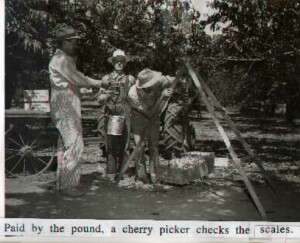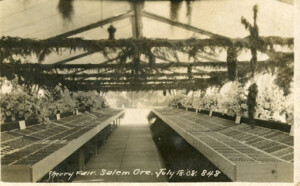The Cherry City
The story of Salem’s cherry industry begins in 1847 when pioneer nurseryman Henderson Lewelling (also spelled Luelling) arrived from Iowa. Lewelling brought with him 700 tiny fruit trees in earth filled boxes. Shortly after arriving in the Willamette Valley, Lewelling took up a land claim near Milwaukee where he established an orchard and the first nursery in the Northwest. In 1850, he was joined in the enterprise by his brother, Seth, and William Meek, who had married one of his daughters. By 1851, the Lewelling nursery had over 18,000 fruit trees ready for sale. This allowed them to establish branch nurseries at Salem and Albany. (No pun intended.)

Cherry pickers gathered around a scale as cherries are being weighed in orchard. Boxes branded Willamette Cherry Growers, Inc. Salem Public Library MJON 0123. WHC Collections 1998.010.0001
Among the cherry trees brought from Iowa was one Napoleon Bigarreau which, for reasons now long forgotten, Mr. Lewelling called “Royal Anne.” From this single misnamed tree, the most profitable cherry variety grown in the Northwest had its origin.
Seth Lewelling is best remembered for his work in developing new fruit varieties. Among these, two black cherries stand out. In 1860, the original Black Republican tree was grown from a seed of a Black Eagle cherry and, in 1875, a Black Republican planting produced a promising seedling that Lewelling named “Bing” after his faithful Chinese helper. The Bing cherry would be Seth Lewelling’s crowning achievement.
When Bing cherries were exhibited at the 1876 Centennial Exposition in Philadelphia, people at first thought, because of their size, they were crabapples. According to reports, the large Bings averaged 35 cherries to the pound and sold in the East for three cents a cherry.
A third black cherry important to the Salem region was developed after the Lewelling orchards were sold to Joseph Hamilton Lambert in 1857. Mr. Lambert developed the “Lambert” which he introduced in 1870.
Royal Annes, Bings, Lamberts, and Black Republicans were the most important varieties in the early Oregon orchards. Due to a lack of fruit canneries in Oregon, cherries from these early orchards were marketed fresh. By using now available rail transportation, Oregon cherries could be refrigerated with ice and shipped to the eastern part of the country where they brought a good price.
The hills surrounding Salem were ideal for cherry orchards, and Salem-grown cherries soon became noted for their quality, size, and flavor. When Robert Stuart Wallace opened the Salem Canning Company in 1890, cherries were included in the initial pack.
Salem’s first Cherry Fair, held in 1903, was a three day celebration sponsored by the Salem Elks Lodge. Events on the program included the queen’s coronation and ball, games, and contests at the State Fairgrounds, a parade with decorated automobiles, and boat races on the river. Industrial displays and exhibits of cherries were arranged in booths along Court Street.

Salb & Gamble, Salem, Ore., 1908, Black and white view of filled boxes of cherries at the Cherry Fair with decorated beams and flowers. Written across the bottom “Cherry Fair, Salem, Ore. July 18, ’08 848” Written on message side: To Irene from Uncle Jake Schropp. Salem, Ore.. Irene Windan, Sandusky Ohio, WHC Collections 2011.006.0728
Salem became known as the Cherry City as a result of the outstanding exhibits at the Cherry Fair held in July, 1907. Sponsored by the Marion County Horticultural Society, this fair was held in conjunction with the fifth annual convention of the Pacific Coast Association of Nurserymen. It was these men who, after viewing the cherry exhibit, passed a resolution declaring it to be “the greatest and finest display of cherries known in history.” By unanimous vote they christened Salem the Cherry City.
Between 1908 and 1912, the Cherry Festival was sponsored by the Salem Board of Trade. After the Salem Cherrians were organized in 1913, they were designated as the group responsible for the annual Cherry Festival. Festivals under their sponsorship were held in 1913 when George F. Rogers was King Bing, and 1914 when Milton Meyers held that post. The passing of years, however, saw the discontinuance of the annual festival, and the yearly celebration became only a memory of oldtimers.
During the first part of the 20th century, Salem’s canning industry grew from one plant to more than ten, and canned cherries were an important part of the Salem pack. With improved refrigeration, rail shipments of fresh cherries also increased in the 1920s. One of the largest shippers was Salem Cherry Growers Association, formed in 1925. Their fresh packing operation was set up at the Max Gehlhar dryer in West Salem.
In 1927, the Gehlhar dryer was the site of the first brined cherry pack using the new brining method developed by Professor Ernest Wiegand of Oregon Agricultural College (Oregon State University). Prior to Wiegand’s method for brining cherries, most brined stock used in manufacturing maraschinos was imported from Italy.
The Salem trading district in 1928 had more than 2,500 acres bearing cherries. With twelve canning plants operating in the area, cherries found a ready market. The average price paid by canners for Royal Annes in 1928 was five to seven cents a pound, with picking costs at one to two cents. Growers received ten cents a pound for Lambert cherries shipped to the East under refrigeration. The largest Lambert cherry orchard in the world, Lambert Cherry Company, was located east of Salem in the Waldo Hills near McCleay. Some red tart cherries of the Montmorency and Kentish varieties were also being handled by the Salem canneries.
With the start of the National Depression in 1930, the demand for canned cherries dropped. This resulted in a large surplus of fresh cherries. To accommodate the oversupply, a number of the Salem processors began brining cherries. Hunt Brothers, Allen Fruit Company, Producers Cooperative, and Salem Cherry Growers Association all established brining operations at this time.
The demand for Royal Anne cherries dropped in 1932, with local canners offering only two cents a pound for the limited quantities they required. To market their cherries, 53 Salem area growers formed a cooperative, Willamette Cherry Growers, Inc. This cooperative became a major force in the brined and, later, maraschino cherry business.
World War II brought a sharp increase in demand for all types of canned food. As packs increased, the price of cherries stabilized, making the war years a profitable time for the cherry grower. Picker shortages during the war created some problems, but the use of platoons of local school children eased the shortage for many growers.
The Salem Cherry Festival had a brief revival following the war. Sponsored by the Salem Cherry Festival Association, a three day celebration was held in July of 1947.
Canned cherry production remained high in the 1950s and 1960s, but consumer tastes were changing. The demand for all types of canned fruit began a decline in the 1970s that continued through the 1980s and 1990s. Today, none of Salem’s canners handle Royal Anne cherries, and only two process black cherries. Red tart cherries are now mostly frozen along with some black cherries. Royal Annes and other light varieties are used almost exclusively for brining stock.
The Salem cherry growing regions have also experienced change in recent years. When orchards no longer deemed productive were removed, they were not being replaced. South and west of Salem, much of the land formerly occupied by orchards is now covered with housing subdivisions.
As a sign of changes that have occurred in the Salem cherry industry, the blossom tours held each spring in the cherry growing regions have been discontinued because so few orchards remain on the old blossom routes.
Written and compiled by Bill Lucas.
Bibliography:
“Cherrians,” Oregon Magazine, April 1933.
Lucas, William. Canning in the Valley, 1998.
Oregon Grower, Volume IV/ Number 5, December 1922.
Salem Chamber of Commerce, Come to Oregon, 1929.
Salem Cherry Festival, 1947.
Willamette Cherry Growers, Inc., The First Fifty Years.
This article originally appeared on the original Salem Online History site and has not been updated since 2006.







Leave A Comment